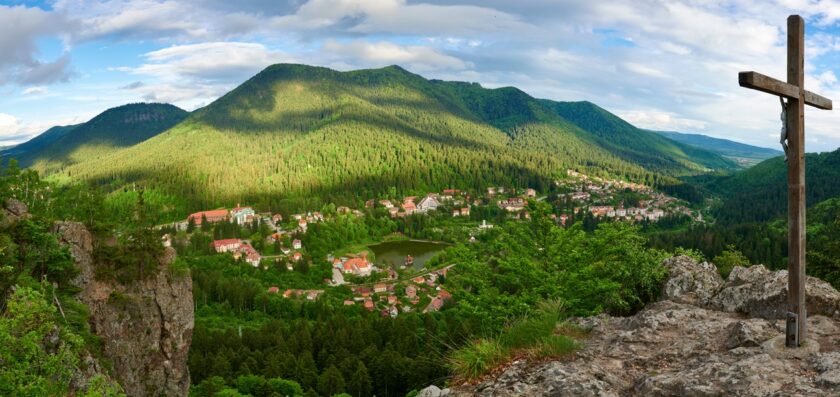Expanding the radius around Liban, Harghita, allows for the exploration of even more captivating sites, including natural wonders, historical landmarks, and cultural experiences in the heart of Transylvania. Here’s a broader look at what you can visit within a larger radius around the village of Liban:
1. Bicaz Gorge (Cheile Bicazului) and Red Lake (Lacul Roșu)
Located about 90 km from Liban, the Bicaz Gorge is one of Romania’s most spectacular natural wonders. Carved by the Bicaz River through massive limestone cliffs, the gorge offers dramatic landscapes with towering walls, sharp turns, and deep valleys. This area is a paradise for rock climbers, hikers, and photographers.
Nearby, the Red Lake (Lacul Roșu) is the largest natural mountain lake in Romania, famous for its hauntingly beautiful setting. The lake was formed in 1838 after a landslide blocked a river, and the still-visible tree trunks sticking out of the water add to its eerie charm. It’s a popular spot for boating, hiking, and nature walks.
2. Băile Tușnad and the Thermal Baths
Băile Tușnad, often referred to as “The Pearl of Transylvania,” is a charming spa town nestled in the Harghita Mountains, about 50 km from Liban. It is famous for its therapeutic mineral waters and thermal baths, which are believed to have healing properties. Visitors come here to relax and rejuvenate in the natural hot springs and enjoy treatments for various health conditions.
Beyond the thermal baths, Băile Tușnad is also a great base for outdoor activities, such as hiking, wildlife watching (including bears), and exploring the nearby forests and lakes.
3. Praid Salt Mine (Salina Praid)
Situated about 55 km from Liban, the Praid Salt Mine is a fascinating underground complex and one of the largest salt mines in Romania. Visitors can explore the mine’s massive chambers, which are filled with sculptures, exhibitions, and even playgrounds, making it a family-friendly attraction. The therapeutic microclimate inside the mine is said to be beneficial for respiratory conditions, and there are designated areas for halotherapy treatments.
Nearby, the Praid Salt Baths offer visitors a chance to soak in saline waters with medicinal benefits.
4. Corund (Korond) – Famous Pottery Village
Around 45 km from Liban, Corund is a well-known center for traditional Székely pottery and crafts. The village’s artisans produce hand-painted ceramics, weaving, and wood carving, using methods passed down through generations. Visitors can watch craftsmen at work, visit local workshops, and purchase unique, handmade items as souvenirs.
5. Sighișoara – The Medieval Citadel
Further afield, about 130 km from Liban, lies Sighișoara, one of the best-preserved medieval towns in Europe and a UNESCO World Heritage site. The citadel, with its narrow, cobbled streets, colorful houses, and fortified towers, feels like stepping back in time. Sighișoara is also the birthplace of Vlad the Impaler, the historical figure who inspired the Dracula legend. Highlights include the Clock Tower, the Church on the Hill, and various museums showcasing the town’s rich history.
Each summer, the town hosts the Sighișoara Medieval Festival, where visitors can enjoy jousting, music, and crafts that celebrate its medieval heritage.
6. Odorheiu Secuiesc (Székelyudvarhely)
Located about 40 km from Liban, Odorheiu Secuiesc is a historical town and a center of Székely culture. The town’s charming architecture, vibrant markets, and historical monuments, such as the Székely Támadt Castle and several old churches, provide insight into the region’s history. The town also offers a lively cultural scene with folk music and art.
Visitors can enjoy the local cuisine, often featuring Hungarian and Székely influences, and explore the region’s traditions in greater depth.
7. Miercurea Ciuc and the Csíki Szekler Museum
About 45 km away, Miercurea Ciuc, the capital of Harghita County, is a hub of Székely culture. One of its main attractions is the Csíki Szekler Museum, where you can learn about the history, culture, and folklore of the Székely people. The town also features the Miko Castle, a 17th-century fortress with beautiful grounds and exhibitions inside.
Miercurea Ciuc is also known for the Șumuleu Ciuc Pilgrimage and its stunning Franciscan Monastery. This pilgrimage, one of the largest in Central Europe, takes place annually and is deeply important to the Hungarian Catholic community in Transylvania.
8. Viscri – Traditional Saxon Village
Though a bit further (about 150 km), Viscri is worth the trip for those interested in rural life and history. This traditional Saxon village is a UNESCO World Heritage site and is known for its fortified church and well-preserved houses. It offers a glimpse into the simple, sustainable lifestyle of the Saxon community, and its cobbled streets and charming atmosphere have drawn global attention.
9. Rupea Fortress
On the way to Viscri, about 125 km from Liban, the Rupea Fortress is one of the oldest and most impressive fortifications in Romania. Perched on a hill, the fortress offers panoramic views of the surrounding landscape and a chance to explore medieval architecture. Its strategic importance throughout history is evident in its thick walls and numerous defensive towers.
10. Bear Watching in Harghita
For wildlife enthusiasts, the Harghita County Bear Watching Tours offer an exciting opportunity to observe Romania’s wild brown bears in their natural habitat. Specialized tours operate in the forests around Liban and other parts of Harghita, providing a safe and ethical way to experience one of Europe’s largest populations of brown bears.
In summary, the region surrounding Liban is rich in diverse experiences, from the stunning natural beauty of the Carpathians and volcanic lakes to cultural immersion in Saxon and Székely traditions. Whether you seek outdoor adventure, historical exploration, or a quiet retreat in nature, this area of Romania is brimming with unforgettable sights and activities.
